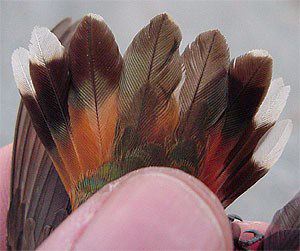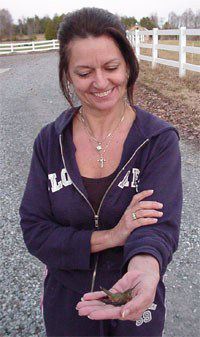 HOME: www.hiltonpond.org |
|||
|
RUFOUS HUMMINGBIRD |

All text & photos © Hilton Pond Center York County, South Carolina, has been a hotbed of vagrant winter hummingbirds, with nine banded here in the past three years. Thus, we almost weren't surprised to take a phone call at midday on 20 December from Gina Pratt of Smyrna, who said she'd had an apparent Selasphorus hummingbird coming to her feeder since early October 2002. Unlike many vagrant hummers we've banded at distant locales, this one was only about ten miles from Hilton Pond Center, so we broke with our usual policy of trapping winter hummingbirds at dawn and told Gina we'd be out to her place that afternoon.  We arrived at the Pratt homestead at 3:45 p.m. and moved Gina's brass-colored feeder into our portable hummingbird trap. To keep the feeder at the same height outside the den window, we placed the trap on an aluminum ladder and set the trigger. Within a minute or two the hummingbird made its first appearance, flitting rapidly around the trap and zooming off to set a spell in a nearby tree.  During the next 45 minutes, the hummer made nearly 30 incoming forays, sometimes perching on the ladder and trap but never entering for a hit of sugar water from the enclosed feeder. It even landed on a nearby sunflower seed feeder several times and probed within, sharing it simultaneously with a flock of House Finches and perhaps gleaning tiny insects that had emerged from the seeds. Thinking the bird was too distracted by the metal of the trap and ladder, we eventually replaced Gina's feeder with one of ours that had lots more red on it--all in the hope of getting the reticent bird's attention. This strategy seemed to go nowhere, for over the next quarter hour the bird's visits became increasingly less frequent--never a good sign when one is trying to trap hummingbirds.
By 5 p.m. the sun was beginning to set and we had about decided we'd need to return another day to catch this bird. Fortunately, however, Gina's husband Foy arrived home from work, greeted us, asked what the heck we were doing, and mentioned that his first cousin was H. Douglas Pratt--the internationally known wildlife artist who painted many color plates in the National Geographic Field Guide to the Birds of North America. As if by magic, the hummingbird suddenly entered the trap, we hit the remote mechanism, and soon we had the elusive rusty-tailed hummer in hand.
Vital Statistics for Rufous Hummingbird #Y14804
If you're interested in sharing your hummingbird observations and learning from other enthusiasts, you may wish to subscribe to Hummingbird Hobnob, our Yahoo!-based discussion group. Also be sure to visit our award-winning Web site for Operation RubyThroat: The Hummingbird Project; on it you'll find almost anything you want to know about hummingbirds, including more information about Hummingbird Banding.
For much more information about hummingbirds, visit Operation RubyThroat: The Hummingbird Project  |

 After examining the bird closely and making our standard measurements, we determined it was indeed a Rufous Hummingbird (S. rufus) rather than the slightly smaller Allen's (S. sasin), and that it was a long-winged female (46mm) with tiny bill corrugations that indicated she hatched out in 2002--undoubtedly either in southern Alaska, western Canada, or the northwestern continental U.S. When we finishing forming and placing a band on the bird's leg, we inserted her bill into a feeder port from which she freely drank. Working quickly in the waning light, we took the photographs that accompany this narrative, just before Gina got to hold and release her Rufous Hummingbird.
After examining the bird closely and making our standard measurements, we determined it was indeed a Rufous Hummingbird (S. rufus) rather than the slightly smaller Allen's (S. sasin), and that it was a long-winged female (46mm) with tiny bill corrugations that indicated she hatched out in 2002--undoubtedly either in southern Alaska, western Canada, or the northwestern continental U.S. When we finishing forming and placing a band on the bird's leg, we inserted her bill into a feeder port from which she freely drank. Working quickly in the waning light, we took the photographs that accompany this narrative, just before Gina got to hold and release her Rufous Hummingbird. Thanks to Gina for summoning us to band this new winter visitor to York County, and to neighbor Clint Wilkins--a 10th grader at York Comprehensive High School--for hanging around to learn from the experience. (Thanks also to bird artist Doug Pratt, who must have sent good hummingbird trapping karma when his name was intoned by cousin Foy in Smyrna.)
Thanks to Gina for summoning us to band this new winter visitor to York County, and to neighbor Clint Wilkins--a 10th grader at York Comprehensive High School--for hanging around to learn from the experience. (Thanks also to bird artist Doug Pratt, who must have sent good hummingbird trapping karma when his name was intoned by cousin Foy in Smyrna.)
 Students at GLOBE-certified schools may submit winter hummingbird observations as part of Operation RubyThroat and GLOBE. Students can also correlate hummingbird observations with data on abiotic factors, including atmosphere, climate, hydrology, soils, land cover, and phenology. See the
Students at GLOBE-certified schools may submit winter hummingbird observations as part of Operation RubyThroat and GLOBE. Students can also correlate hummingbird observations with data on abiotic factors, including atmosphere, climate, hydrology, soils, land cover, and phenology. See the 


